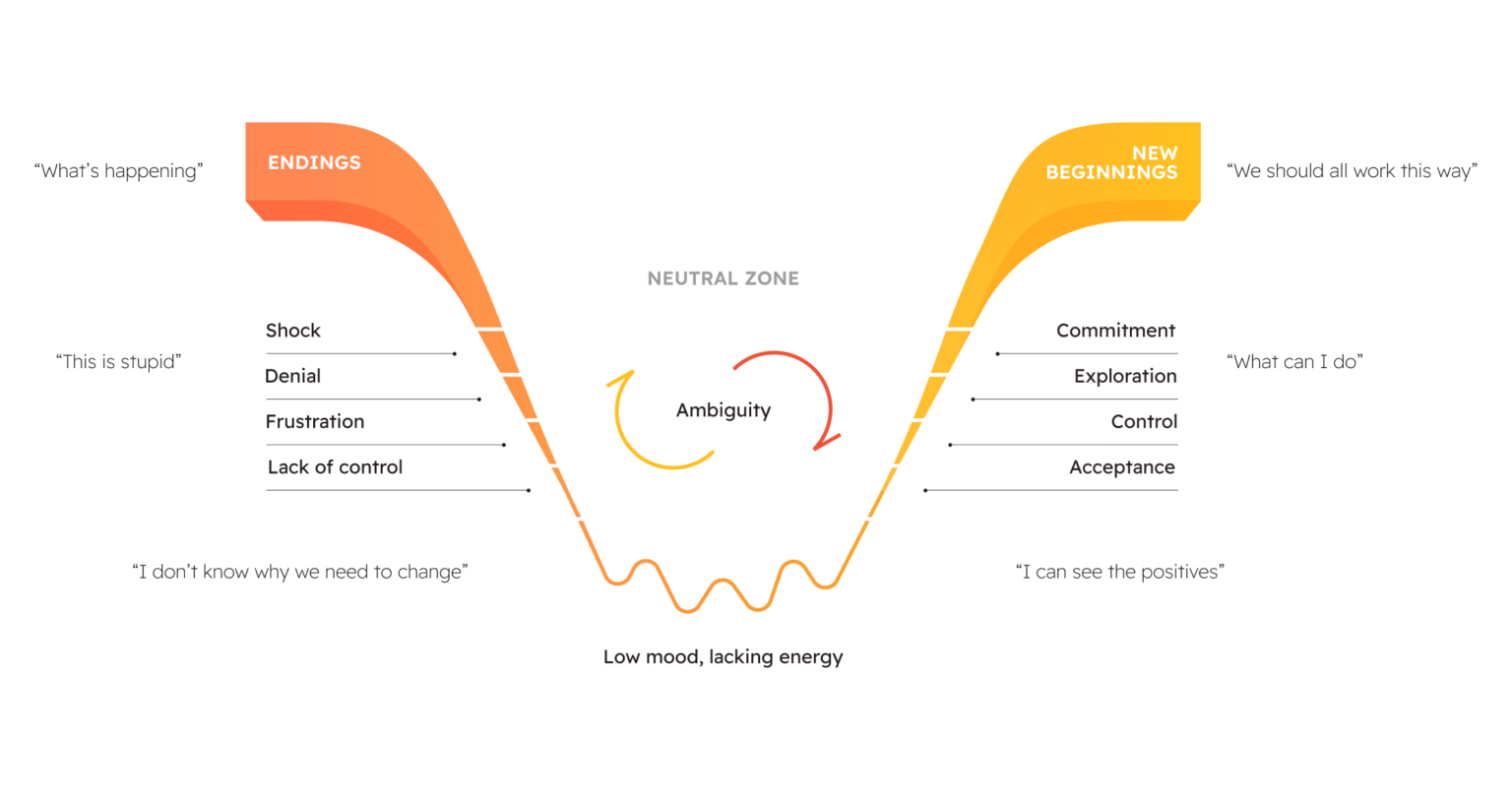The Change Curve: Providing the right support at each stage
The Change Curve: Providing the right support at each stage
5 minutes

Change is external and situational, such as shifts in organisational structure, reporting lines, job content, or systems, and it can happen quickly and visibly.
On the other hand, transition is internal and psychological, taking more time and being less visible. It is caused by change and involves personal challenges such as feelings of loss, uncertainty, and concern about the future. Regardless of the cause of change, most people tend to react similarly. The Change Curve can help leaders anticipate and prepare for people’s reactions to change.
Extensive studies have shown a common sequence of reactions as depicted on the curve, and how they relate to the three different stages of transition:
- Endings: People have to let go of what was once normal, predictable, and comfortable.
- Neutral Zone: A sense of uncertainty, mixed emotions and a state of flux.
- New Beginnings: People start to see possibilities, be more positive and plan for the future.
These different stages of change can lead to various behaviors and symptoms, as noted in the diagram below.

Your attitude towards change and the support you provide your team are critical in how your team will experience the change.
Your role as a leader during a time of change is to:
- Provide support and ensure the wellbeing of your team;
- Provide clear, transparent and consistent communication;
- Be a positive and professional role model;
- Facilitate collaboration, inclusion and help resolve any challenges.
Here are some strategies to help you navigate each transition phase. The same advice applies to your team as individuals.
- Acknowledge feelings: Recognise and validate the emotions team members are experiencing. Offer a listening ear and show empathy. Don’t try and rush their transition but recognise if they get stuck. Be available and visible.
- Communicate clearly: Provide clear, honest, and transparent information about what is changing and why. This helps reduce uncertainty and misunderstandings and builds trust.
- Recognise the loss: Acknowledge and value what was achieved and what was good without heightening anger or resentment of the change. Help people respectfully let go of the past.
- Provide support resources: Offer access to counseling services, employee assistance programs, or other support resources and information to help team members cope with the transition.
- Create a transition plan: Create a transition plan with details and share this with the team and allow their input. This helps to provide clarity and reduce anxiety about the unknowns. It also shows that the change is being managed thoughtfully and systematically.
- Encourage open dialogue: Foster an environment where team members feel safe to express their concerns, ideas, and uncertainties. Regular check-ins and feedback sessions can be very helpful. Active listening is important here.
- Role model: Share your own strategies in managing change and transition, encourage a growth mindset and gently promote a focus on opportunities whilst acknowledging loss
- Connect to motivations: Consider the motivations of each team member and look for strategies to support them. This might be recognition of effort, opportunities for development or training, taking on a challenge or creating opportunities for social connection.
- Promote collaboration: Encourage teamwork and collaboration to solve problems, generate new ideas and support each other. This can help build a sense of community and collective purpose.
- Set short-term goals: Establish achievable short-term goals to provide direction and a sense of accomplishment, helping to maintain motivation and momentum.
- Reinforce vision and goals: Clearly articulate the vision for the future and how each team member’s role contributes to this new direction. This helps to create a shared sense of purpose.
- Celebrate milestones: Recognise and celebrate achievements, no matter how small or significant, as the team adapts to the new ways. This helps to build confidence and reinforce positive changes.
- Provide continuous feedback: Offer constructive feedback and positive reinforcement to guide team members as they embrace new processes and roles.
- Encourage ideas and opportunity: Encourage team members to experiment, identify opportunity and take initiative. This can help make the new beginning more tangible and real, sustain enthusiasm and build engagement.
- Empower team members: Give team members the autonomy to take ownership of their new roles and responsibilities as much as possible. Encourage them to make decisions and contribute ideas, helping them feel more invested, engaged and committed to the success of the change.
Remember to not assume where each person is on the curve and that they may move around it: check-in, be flexible and adapt. By taking these actions, you can effectively support your team members through each stage of the change process, helping them to navigate transitions smoothly and emerge stronger and more cohesive. And always remember to look after yourself as well, to ensure that you are the best leader you can be.
Hellomonday